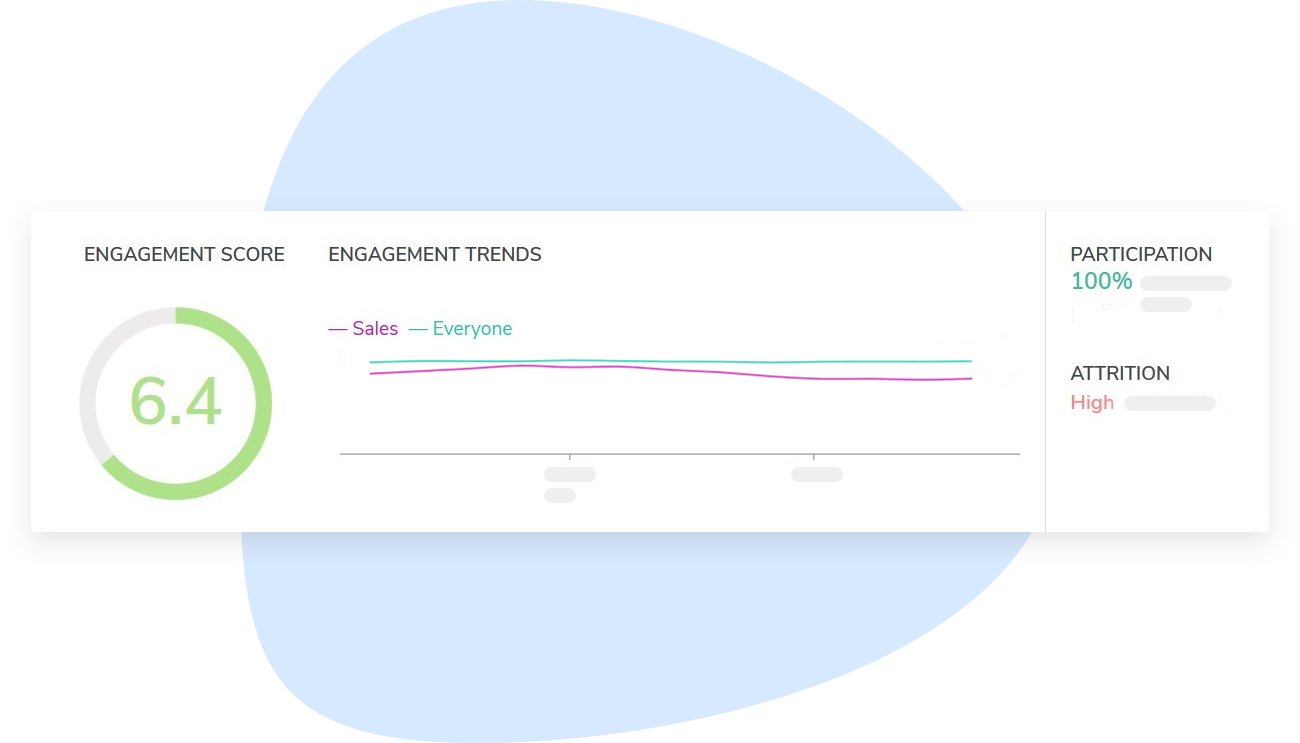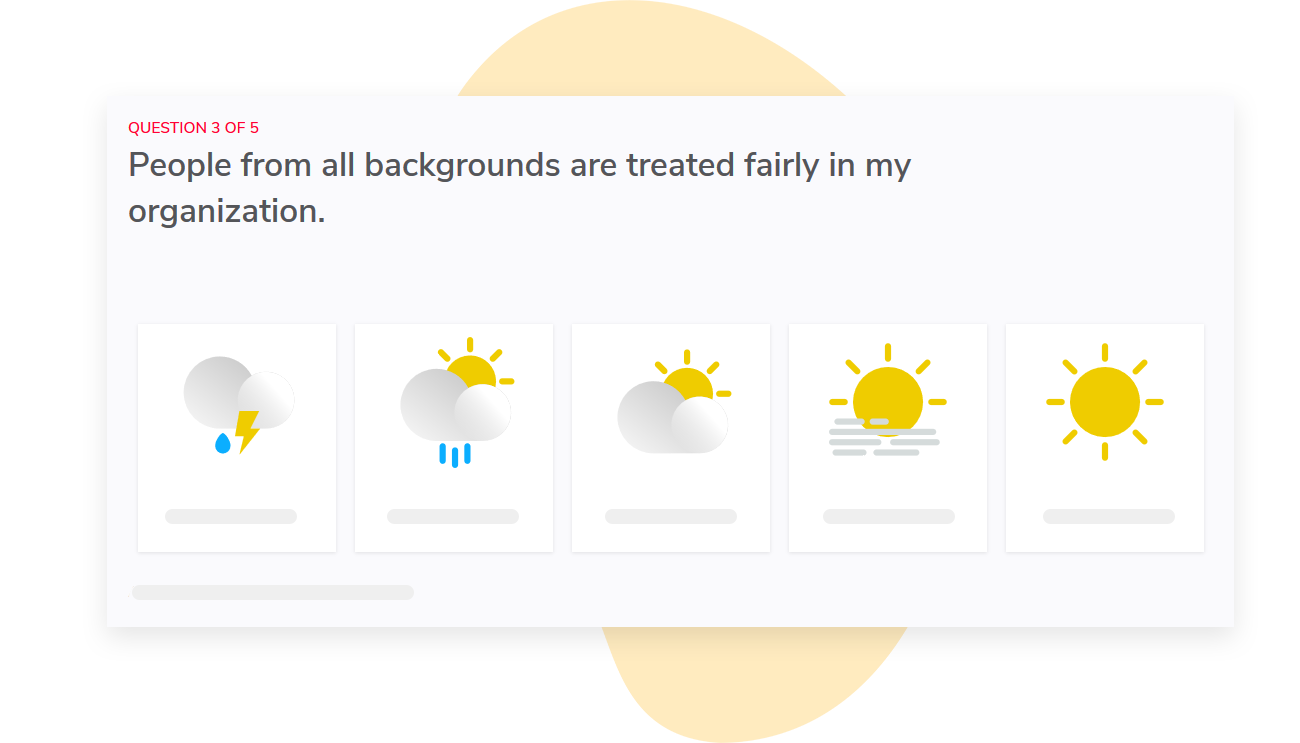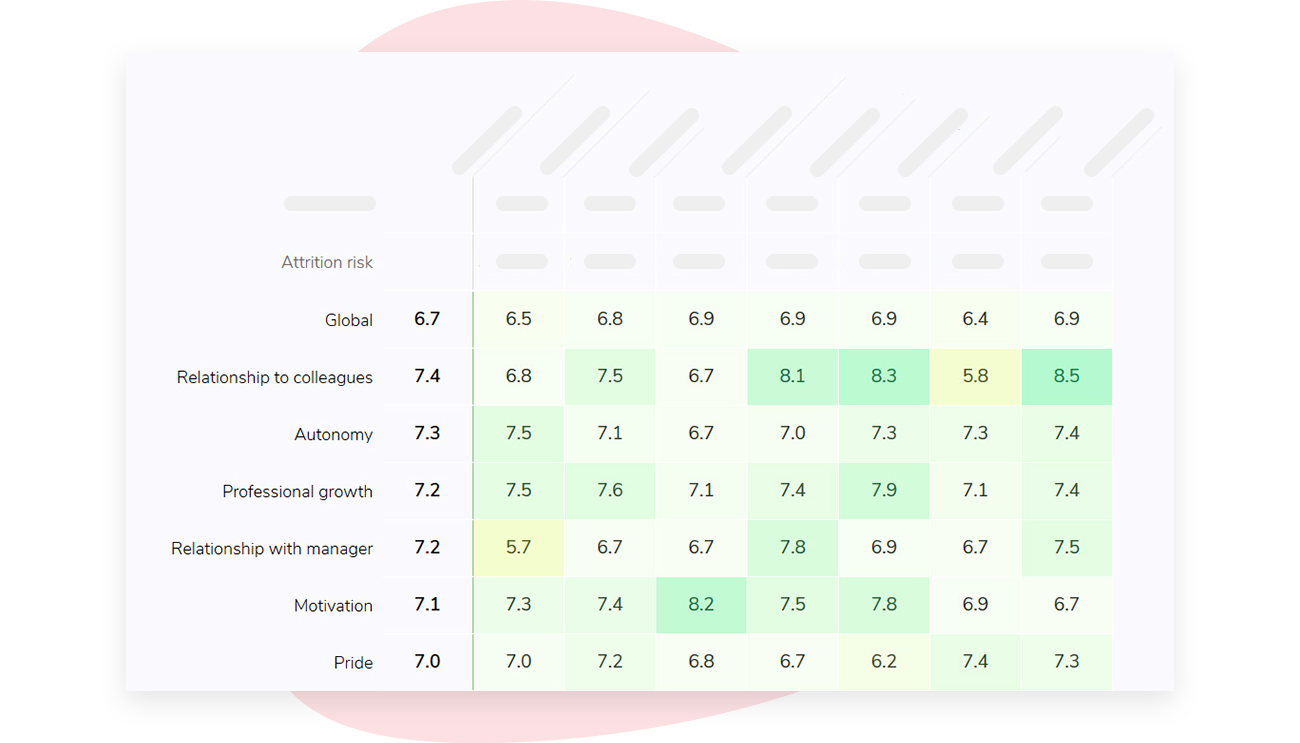Employee experience platform
Empower your organization to take actions that put your people first.
Sparkbay gathers continuous feedback from every employee to improve employee experience.
How Sparkbay improves employee experience
Real-time insight
Sparkbay collects feedback from every employee in your organization.
Unlike traditional surveys, Sparkbay’s pulse surveys take just minutes to complete and deliver data instantly.

Ask the right questions
With its intelligent question assignment, Sparkbay delivers the right question to the right person at the right time. That way, you'll uncover disengagement patterns as soon as they arise.

Make data-driven decision
Making the right decisions is essential to your success.
Sparkbay’s interactive dashboards will give your leaders actionable insights for every employee segment: direct manager, department, office, tenure, title, demography and more.

Act on feedback: close the loop
Collecting employee feedback is only the beginning.
Sparkbay turns your managers into agents of change within their teams, with actionable personalized recommendations.

Improve employee experience
See in actionEmployee experience platform software FAQ
What is an employee experience platform?
An employee experience platform is a software platform that helps organizations create, manage, and improve the experiences of their employees. It integrates various HR tools and systems, such as onboarding, performance management, employee engagement, benefits, learning and development, recognition, and feedback, into a single platform.
The purpose of an employee experience platform is to create a seamless and consistent experience for employees throughout their entire journey with the organization, from recruiting to offboarding. It aims to increase employee satisfaction, engagement, productivity, and retention by providing personalized, user-friendly, and relevant experiences, as well as empowering employees with self-service capabilities.
Employee experience platform can also leverage data analytics and artificial intelligence to provide insights and recommendations to managers and HR professionals to optimize the employee experience and identify areas for improvement. An employee experience platform can be cloud-based or on-premises, and it can be customized to fit the specific needs and culture of each organization.
What is employee experience?
Employee experience refers to the sum of all interactions and experiences an employee has with an organization over the course of their employment. It encompasses everything from the initial recruitment and onboarding process, to their day-to-day work environment, to their overall job satisfaction and sense of purpose, to their eventual departure from the organization.
An employee's experience can be influenced by a wide range of factors, including the physical work environment, company culture, management style, work-life balance, compensation and benefits, opportunities for growth and development, and more.
In recent years, the concept of employee experience has gained increasing attention from organizations as they seek to attract and retain top talent. By focusing on creating a positive, engaging, and fulfilling employee experience, organizations can improve employee morale and productivity, reduce turnover, and ultimately, improve the overall success of the business.
Top benefits and features of an employee experience platform
An employee experience platform can offer many benefits and features to organizations, including:
- Integration: An employee experience platform can integrate various HR tools and systems, such as onboarding, performance management, employee engagement, benefits, learning and development, recognition, and feedback, into a single platform.
- Personalization: An employee experience platform can provide personalized experiences for each employee, based on their individual needs and preferences.
- Automation: An employee experience platform can automate many HR processes, such as onboarding and offboarding, training, feedback and recognition, and performance management.
- Data and analytics: An employee experience platform can collect and analyze data on employee engagement, satisfaction, and performance, providing insights and recommendations to help organizations optimize the employee experience.
- Collaboration: An employee experience platform can promote collaboration and communication among employees, teams, and departments, improving teamwork and productivity.
- Mobile access: An employee experience platform can offer mobile access, allowing employees to access HR tools and information from anywhere, at any time.
- Flexibility: An employee experience platform can be customized to meet the specific needs of each organization, providing flexibility in design and functionality.
- Employee self-service: An employee experience platform can offer self-service functionality, allowing employees to manage their own HR-related tasks, such as requesting time off, updating personal information, and accessing training materials.
Overall, an employee experience platform can help organizations create a positive, engaging, and fulfilling experience for their employees, leading to improved employee satisfaction, retention, and productivity, and ultimately, a more successful business.
How to set up an employee experience platform for your company
Setting up an employee experience platform for your company can be a complex process, but here are some general steps to consider:
- Identify your needs: Begin by identifying your organization's specific needs and goals for an employee experience platform. What HR processes and systems would you like to integrate into the platform? What are your priorities for improving the employee experience? What data and analytics would be most valuable to your organization?
- Evaluate vendors: Research and evaluate vendors that offer employee experience platforms that meet your organization's needs. Look at factors such as functionality, customization options, scalability, data security, and pricing.
- Involve stakeholders: Involve stakeholders from across the organization in the selection process to ensure that the chosen platform meets the needs of all departments and employees.
- Plan implementation: Develop a plan for implementing the employee experience platform, including timelines, budgets, and resources required. Consider the needs of different departments and employee groups and plan for any necessary training and support.
- Test and refine: Test the platform with a pilot group of employees and refine the system based on their feedback. Continue to gather feedback and make adjustments as needed to ensure the platform is meeting the needs of employees and the organization.
- Launch and communicate: Launch the platform and communicate its benefits and features to employees. Provide training and support to ensure that all employees can use the platform effectively.
- Monitor and evaluate: Monitor the use and effectiveness of the platform, and evaluate its impact on employee satisfaction, retention, and productivity. Use data and analytics to make ongoing improvements and optimize the employee experience.
Overall, setting up an employee experience platform requires careful planning, collaboration, and ongoing evaluation and refinement to ensure that the platform is meeting the needs of the organization and its employees.
What are some best practices for implementing an employee experience platform?
Here are some best practices for implementing an employee experience platform:
- Involve key stakeholders: Involve HR leaders, IT professionals, and other key stakeholders in the selection process. Make sure everyone understands the benefits and capabilities of the platform.
- Develop a comprehensive plan: Develop a comprehensive plan for implementing the platform. The plan should include timelines, training schedules, and communication strategies to ensure a successful launch.
- Provide training and support: Provide adequate training and support to employees to ensure that they know how to use the platform effectively. This can include online tutorials, in-person training sessions, and ongoing support.
- Monitor and evaluate effectiveness: Monitor and evaluate the effectiveness of the platform over time. This can include collecting feedback from employees, tracking engagement and performance metrics, and identifying areas for improvement.
- Customize the platform: Customize the platform to meet the specific needs of your organization. This can include integrating existing HR processes and systems, as well as adding new features that are specific to your organization.
- Communicate effectively: Communicate effectively with employees about the new platform. This can include promoting the benefits of the platform, providing regular updates, and addressing any concerns or questions that employees may have.
- Ensure data security: Ensure that the platform is secure and that employees' data is protected. This can include implementing data encryption, restricting access to sensitive data, and regularly testing the platform's security measures.
What types of organizations can benefit from an employee experience platform?
An employee experience platform can benefit any type of organization that values employee engagement and retention. Here are some examples of organizations that can benefit from an employee experience platform:
- Large enterprises: Large enterprises with a significant number of employees can benefit from an employee experience platform to centralize communications, track performance and goals, and manage learning and development opportunities.
- Small and medium-sized businesses: Small and medium-sized businesses can benefit from an employee experience platform to automate HR processes, track employee data, and provide opportunities for employee growth and development.
- Remote and distributed teams: Organizations with remote or distributed teams can benefit from an employee experience platform to keep employees connected and engaged, regardless of their physical location.
- Multi-location businesses: Organizations with multiple locations can benefit from an employee experience platform to provide consistent communication and engagement across all locations.
- High-growth companies: High-growth companies can benefit from an employee experience platform to scale HR processes and provide support for employees as the company rapidly expands.
- Companies with high turnover: Companies with high turnover rates can benefit from an employee experience platform to increase employee engagement and retention, which can ultimately reduce turnover and save the company money.
In summary, any organization that values employee engagement, and retention, can benefit from an employee experience platform.
